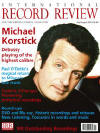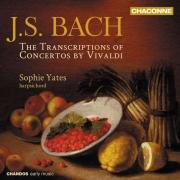Texte paru dans: / Appeared in:
*

International Record Review - (07-08//2013)
Pour
s'abonner / Subscription information
Chandos
CHAN0796

Code-barres / Barcode : 0095115079621
Bach’s fascination with the music of Vivaldi is generously displayed in the concertos he transcribed for keyboard. In addition to the three for organ (BWV592, 593 and 596) he also arranged six for harpsichord (BWV972, 973, 975, 976, 978 and 980). Sophie Yates here presents these six harpsichord transcriptions along with two of concertos by Alessandro Marcello (BWV974) and his brother Benedetto (BWV98 1). All were made between 1713 and I714 while Bach was at Weimar and the notable thing about them all is just how utterly Bachian they sound whilst remaining astonishingly faithful to the original. As Yates puts it in her own booklet note, ‘one of the main points to appreciate when playing or listening to these pieces is the manner in which Bach adapts the string writing so artfully for the harpsichord.’
In Weimar there was an orchestra devoted to the performance of Italian concertos, so Bach clearly got to know the genre well. Yet while Italian concertos were clearly very popular, there has always been a question mark hanging over why Bach went to the effort of making such eminently performable transcriptions for keyboard. In his biography of Bach, Forkel suggested that ‘He heard them so often praised as excellent compositions that he hit on the happy idea of arranging them complete for his keyboard’, but that does not begin to offer an answer to the question of why some were designed for organ and some for harpsichord. More interestingly was Bach’s decision to transcribe Alessandro Marcello’s Oboe Concerto for the harpsichord rather than, as logic would seem to dictate, the wind-blown organ with its reed stops voiced to sound very much like an oboe. Yet, according to Yates, it was this arrangement which ‘first drew attention to the work’.
Writing a an organist, I have always felt quite drawn to Bach’s Vivaldi transcriptions for that instrument and largely unconvinced by the less orchestrally sympathetic timbres of the harpsichord. Yates convinces me otherwise. Indeed, her performances vividly demonstrate just how ingenious these transcriptions are. The mighty string chords which open BWV973 adopt here a hefty percussive edge which is so potently reminiscent of aggressive down-bows, while the fond scales in parallel and contrary motion seem like extracts from a volume of keyboard technical studies, so wholly idiomatic do they sound. Similarly the fugal writing in the Vivace of Benedetto Marcello’s four-movement Concerto and the short—lived polyphonic writing which opens BWV97S seem tailor-made for the harpsichord, while the slow movement of BWV972 manages to sound idiomatic on the harpsichord while in no way hiding its origins as a piece for solo violin and throbbing continuo . The finale of the same concerto reveals Yates in all her virtuoso glory pealing off notes by the ream, pumping out great chords and generally dancing around the keyboards of this two manual 1996 copy by Andrew Garlick of a mid-eighteenth-century Goujon. Perhaps only the tiresomely repeated echo effects in the opening movement of BWV976 begin to pal and one starts to crave string colour over the harpsichord’s weightiness of tone, but Yates’s instinctive musicianship saves the day and we can simply savour the magnificence of this fine instrument.
This is a thoroughly invigorating recording. The
repertoire combines the open-hearted entertainment factor of Vivaldi with
the intellectual strength of Bach, and Yates brings it all vividly to life
through playing of enormous generosity of spirit. Gary Cole’s outstanding
recording, made in St George’s, Brandon Hill, Bristol is every bit as
magnificent as both the music and the playing.
Cliquez l'un ou l'autre
bouton pour découvrir bien d'autres critiques de CD
Click either button for many other reviews


